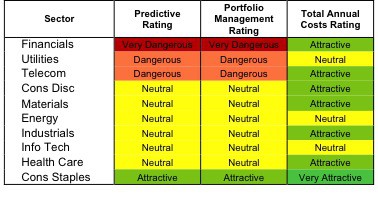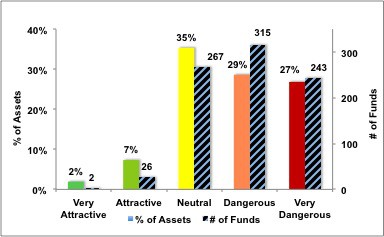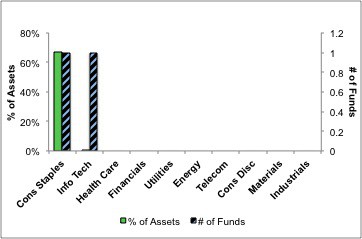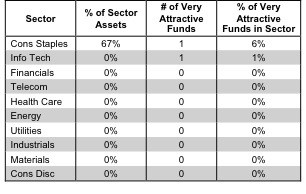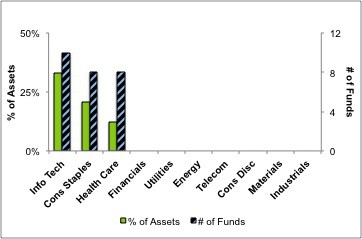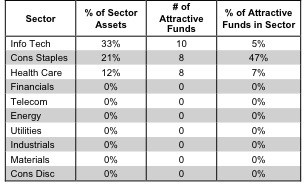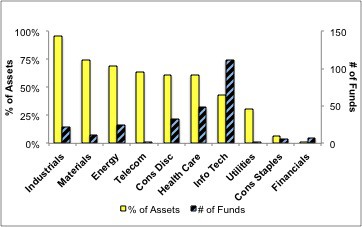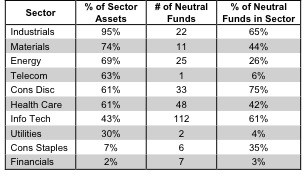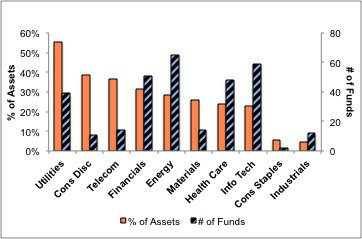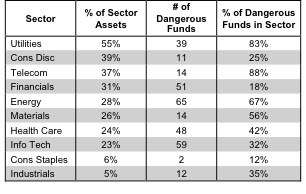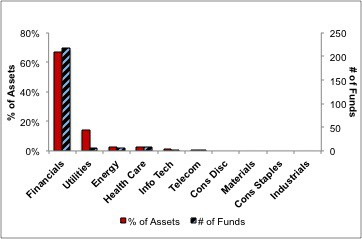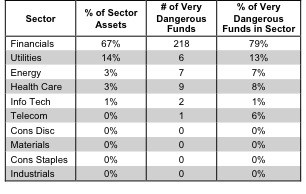At the beginning of the first quarter of 2013, only the Consumer Staples Sector earns an Attractive rating. My sector ratings are based on the aggregation of my fund ratings for every ETF and mutual fund in each sector. Reports on all sectors will follow per our 1Q13 Best & Worst Sector Preview.
Investors looking for sector funds that hold quality stocks should look no further than the Consumer Staples and Information Technology sectors. Only these sectors house Attractive-or-better rated funds. Figures 6 and 7 provide details. The primary driver behind an Attractive fund rating is good portfolio management, or good stock picking, with low total annual costs
Note that the Attractive-or-better Predictive ratings do not always correlate with Attractive-or-better total annual costs. This fact underscores that (1) low fees can dupe investors and (2) investors should invest only in funds with good stocks and low fees.
See Figures 4 through 13 for a detailed breakdown of ratings distributions by sector. See my free ETF & mutual fund screener for rankings, ratings and free reports on 7000+ mutual funds and 400+ ETFs. My fund rating methodology is detailed here.
All of my reports on the best & worst ETFs and mutual funds in every sector and investment style are available here.
Figure 1: Ratings For All Sectors
To earn an Attractive-or-better Predictive Rating, an ETF or mutual fund must have high-quality holdings and low costs. Only 28 sector ETFs and mutual funds meet these requirements, which is only 3% of all sector ETFs and mutual funds.
First Trust NASDAQ Technology Dividend Index Fund (TDIC) is my top Information Technology sector ETF. It gets my Very Attractive rating by allocating over 57% of its value to Attractive-or-better-rated stocks.
Cisco Systems Inc. (CSCO) is one of my favorite stocks held by TDIC. With an ROIC of 18%, CSCO’s profitability ranks in the top quintile. Since 1998, Cisco’s NOPAT has grown 15% compounded annually. Nevertheless, the company’s stock, at ~$21/share, implies its NOPAT will permanently decline by over 30%. Low expectations and high cash flows mean good risk/reward for investors.
Rydex Series Fund: Utilities Fund (RYUTX) is my worst Utilities sector mutual fund. It gets my Very Dangerous rating by allocating over 89% of its value to Neutral-or-worse-rated stocks, and to make matters worse, nails investors with total annual costs of 6.49%.
Dominion Resources Inc. (D) is one of my least favorite stocks held by RYUTX. It gets my Dangerous rating. Both its economic earnings and its free cash flow yield are negative, at 4%, the company’s ROIC is in the bottom quintile. And yet, the valuation of the stock at ~$53/share implies the company’s profits will grow by nearly 25%. Those are high expectations for a company with negative cash flows. There are too many other more attractive stocks for investors to settle for D.
Figure 2 shows the distribution of our Predictive Ratings for all ETFs and mutual funds.
Figure 2: Distribution of ETFs & Mutual Funds (Assets and Count) by Predictive Rating
Figure 3 offers additional details on the quality of the sector funds. Note that the average Total Annual Cost of Very Dangerous funds is almost 6 times that of Very Attractive funds.
Figure 3: Predictive Rating Distribution Stats
 * Avg TAC = Weighted Average Total Annual Costs
* Avg TAC = Weighted Average Total Annual Costs
Source: New Constructs, LLC and company filings
This table shows that only the best of the best funds get our Very Attractive Rating: they must hold good stocks AND have low costs. Investors deserve to have the best of both and we are here to give it to them.
Ratings by Sector
Figure 4 presents a mapping of Very Attractive funds by sector. The chart shows the number of Very Attractive funds in each sector and the percentage of assets in each sector allocated to funds that are rated Very Attractive.
Only 2 sector funds earn my Very Attractive rating. Consumer staples is by far the most attractive sector, with its ETFs and mutual funds allocating 67% of assets to companies earning a Very Attractive rating.
Figure 4: Very Attractive ETFs & Mutual Funds by Sector
Figure 5 presents the data charted in Figure 4
Figure 5: Very Attractive ETFs & Mutual Funds by Sector
Figure 6 presents a mapping of Attractive funds by sector. The chart shows the number of Attractive funds in each sector and the percentage of assets allocated to Attractive-rated funds in each sector.
Note that the Information Technology, Consumer Staples, and Health Care sectors are the only sectors that house Attractive-rated funds.
Figure 6: Attractive ETFs & Mutual Funds by Sector
Figure 7 presents the data charted in Figure 6.
Figure 7: Attractive ETFs & Mutual Funds by Sector
Figure 8 presents a mapping of Neutral funds by sector. The chart shows the number of Neutral funds in each sector and the percentage of assets allocated to Neutral-rated funds in each sector.
Figure 8: Neutral ETFs & Mutual Funds by Sector
Figure 9 presents the data charted in Figure 8.
Figure 9: Neutral ETFs & Mutual Funds by Sector
Figure 10 presents a mapping of Dangerous funds by fund sector. The chart shows the number of Dangerous funds in each sector and the percentage of assets allocated to Dangerous-rated funds in each sector.
Figure 10: Dangerous ETFs & Mutual Funds by Sector
Figure 11 presents the data charted in Figure 10.
Figure 11: Dangerous ETFs & Mutual Funds by Sector
Figure 12 presents a mapping of Very Dangerous funds by fund sector. The chart shows the number of Very Dangerous funds in each sector and the percentage of assets in each sector allocated to funds that are rated Very Dangerous.
Financial sector ETFs and mutual funds should be avoided due to the fact that they allocate 67% of their assets to companies that earn a Very Dangerous rating.
Figure 12: Very Dangerous ETFs & Mutual Funds by Sector
Figure 13 presents the data charted in Figure 12.
Figure 13: Very Dangerous ETFs & Mutual Funds by Sector
Sam McBride contributed to this report.
Disclosure: David Trainer owns CSCO. David Trainer and Sam McBride receive no compensation to write about any specific stock, sector or theme.

